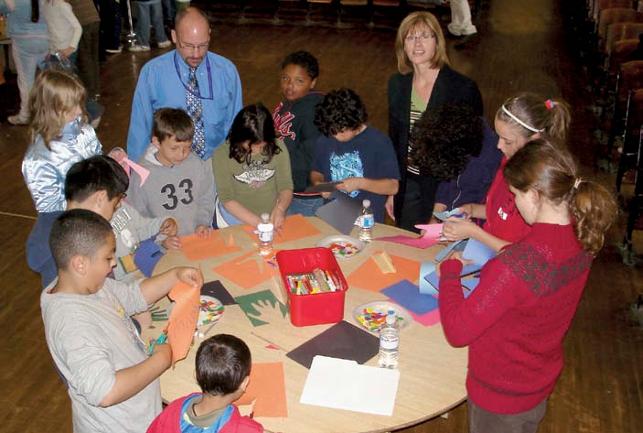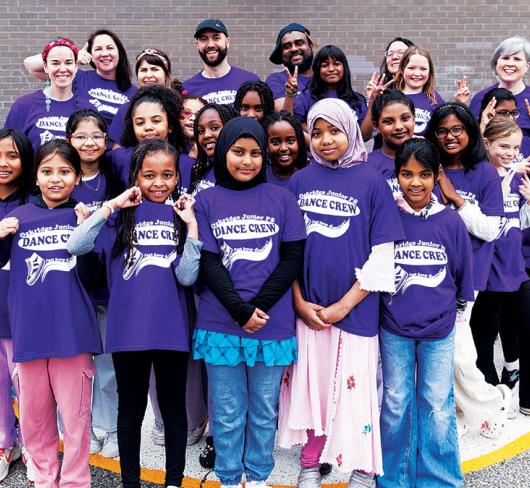
Imagining Poverty: ETFO’s Professional Learning Projects: Bridging the Gap Between Student Needs and Teacher Understanding
One cold winter morning I was teaching my grade 8 class when halfway through the first period Joe came in, late as usual. He was carrying a late slip and appeared angry because of his latest detention, so I took him out into the hallway to try to calm him down. I noticed that his blue jeans were wet and asked him about it. He told me he had no clean clothes that morning and had to wash his and his younger brother’s clothes. There wasn’t time to dry them, so Joe put on his wet jeans and came to school. He added that his mother had to go into work early, so it was his responsibility to take care of his younger brother.
On a warm day in June, the entire school was excited. It was the day of our annual talent show, and everyone was enjoying the acts, including that of a group of Junior boys who performed a well-orchestrated and gymnastic dance set. A few weeks later some staff members were at a workshop on gangs and were shocked to find out that gangs often communicate hidden messages through dance. Our school may inadvertently have been an accomplice to a possible gang advertisement.
Our school has a large number of students experiencing persistent poverty. These two experiences reveal, on one hand, the problems that these children struggle with and, on the other, the enticement of gangs, which often starts students on the downward spiral of the school-to-prison pipeline. Researchers have found a significant correlation between persistent childhood poverty – lasting at least eight years – and delinquency.1 They suggest that its effect occurs as young as grade 3, which implies that this is a critical decision point in children’s lives.
Our staff had been struggling with the question of how middle-class teachers can respectfully bridge the socioeconomic gap when we don’t really understand the entire range of our students’ needs. Then ETFO’s Danny Project arrived, and we saw it as a possible catalyst for change. There was a holiday air of excitement as we came together to determine how to use the funds most wisely to best meet the needs of our students and enrich their lives. Little did we know all the twists and turns our Danny Project would take during our journey to bridge the gap.
Enriching student learning
As part of our involvement in the Danny Project, we received funds for special projects that we designed ourselves. Our first and most important project, the enrichment experiences project involving half of our special funds, focused on broadening our students’ learning. Most classes have been awarded two field trips. Every class will attend a performance of the Windsor Symphony Orchestra, something most of our students have never done. Our grade 5 students were also given the exciting opportunity to accompany the symphony, playing recorders. We purchased recorders with some of the Danny funds, and taught students “A Simple Melody,” which they performed beautifully with the orchestra. We decided to add a further element to this and asked our students to design a T-shirt, selecting the best design for the performance. The local evening news program reported on the performance and included interviews with some of the grade 5 students. Imagine the excitement of being on television!
The nature nook
Our second project, the nature nook, will beautify the exterior of our school. The project involves pulling out dead and rotting stumps in the existing outdoor nature nook, planting a selection of local prairie grasses and installing benches around the perimeter, so that classes can use this area during the day. Our Earth Patrol student team was to design the benches and their arrangement. Unfortunately, we did not take into consideration the board requirement that benches be installed by the board-approved supplier, which doubled the estimated cost. To deal with this unexpected expense, the Earth Patrol decided on a school fundraising project. Many of our parents got involved, a first for most, and formed a team to contribute plants and flowers to further enrich this project. The nook is a success but it did remind us of the need to discuss each project with all key stakeholders before finalizing it and the budget.
Reading enrichment
Our school has struggled for years with the fact that we have some of the lowest EQAO reading scores in our district. Accordingly, we decided to provide a reading enrichment project for our weak readers. All classes up to the Intermediate level will be given a listening centre and audio books, the selections to be based on student preferences.
Taking steps against gangs
The police have recently informed us that our high schools and surrounding community have gangs that are increasingly recruiting members from urban elementary schools. Accordingly, as our fourth Danny Project, we decided to arrange for our staff to receive a half-day presentation on gangs from a local RCMP officer. This project has been progressing slowly due to the difficulties of arranging for occasional teachers and coordinating with the RCMP.
Building community
As our staff was discussing the progress of the various Danny Projects and the enthusiasm that they have generated, someone suggested a school-wide team-building day. This year our staff was trained in TRIBES, which involves training small groups of students to work together collaboratively in each classroom for the entire school year. In her book Tribes: A New Way of Learning and Being Together, Jeanne Gibbs states that this process creates a caring environment for cooperative learning, and provides structure for positive interaction and continuity for these working groups. We decided to assign all students to 20-person teams made up of students from all grades. Each team participated in various 50-minute TRIBES activities. The students loved this activity day, and have been asking, “When can we do it again?” Their tremendous response led us to decide on another community-building day for our school before the end of the school year.
Rewarding student success
More recently, our staff was discussing the need to create some type of positive reinforcement for students who have had a successful week at school. Someone suggested ice skating at a rink across the street. Staff contacted a local church who loaned us several dozen pairs of skates. For six weeks, during Friday lunch hours, staff took the qualifying students over to the ice rink to skate. Many of our students have never had skates and were given their first opportunity to learn this skill. They enjoyed this so much that they subsequently asked us “What are we doing next?”
The enthusiasm continues to build. Morale is up, and suspensions are down. It is a most wonderful time
in the rebirth of our school community.
Notes
1 G. R Jarjoura, R. A. Triplett, & G. P. Brinker. “Growing up poor: Examining the link between persistent childhood poverty and delinquency.” Journal of Quantitative Criminology, 2002. 18:2, 159-187.
2 Jeanne Gibbs. Tribes: A new way of learning and being together. CenterSource Systems, LLC: Windsor, CA: 2001.

